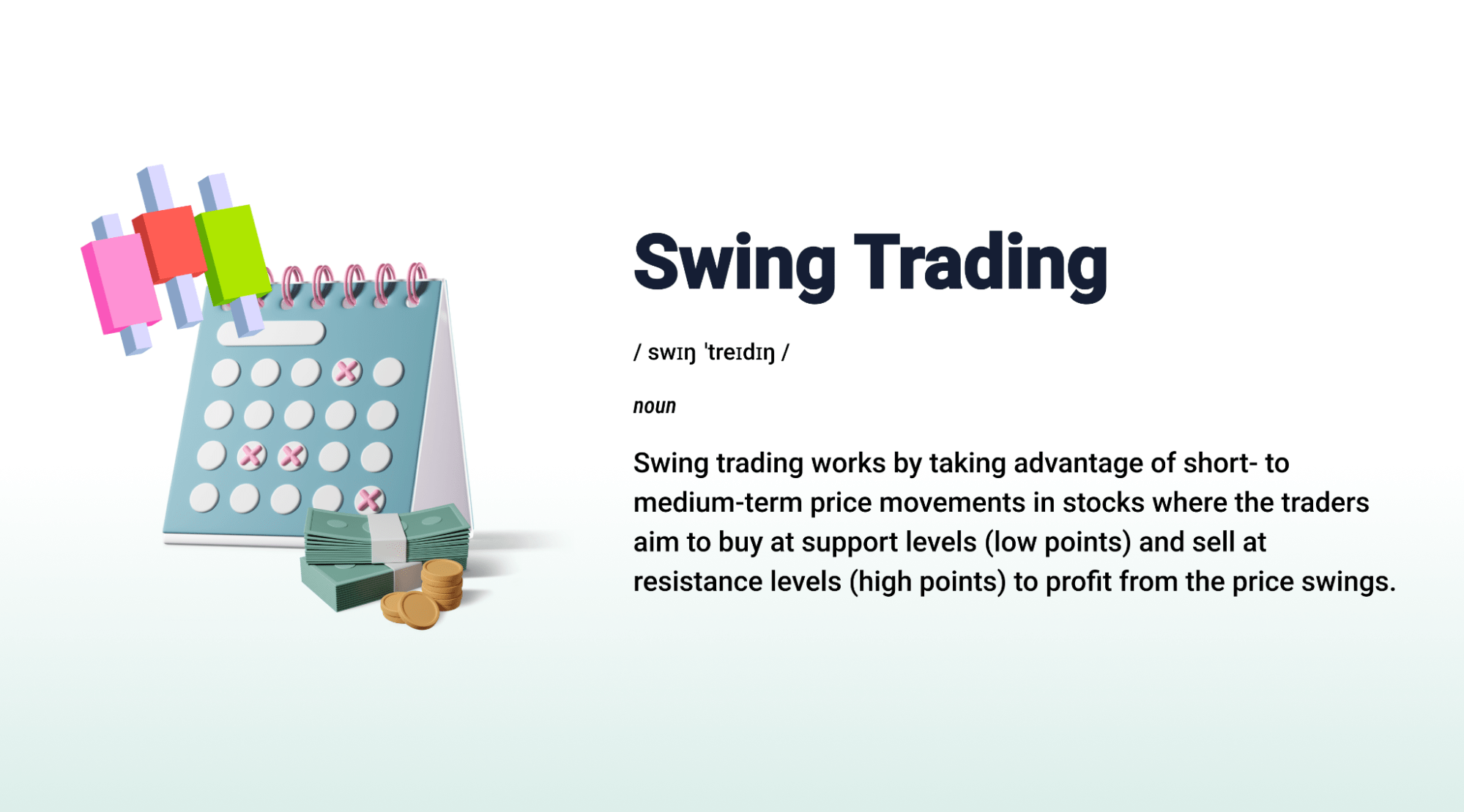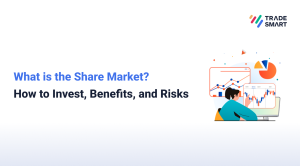
Swing trading is the best trading strategy used in the stock market to profit from short- to medium-term price movements. Unlike day trading, which involves buying and selling stocks within the same day, swing traders hold onto their positions for several days or weeks.
Swing traders aim to capitalize on the “swings” or fluctuations in stock prices, buying at low points and selling at high points. They often use technical analysis to identify stocks with short-term price momentum and employ risk management strategies to protect their capital.
Overall, swing trading stocks are known for offering larger margins compared to other strategies, making it an essential part of many investors’ portfolios. Investors often seek clarity on the swing trading meaning to understand how it differs from other trading strategies. Continue reading this article to understand exactly what is swing trading in stock market:
What Are The ‘Swings’ In Swing Trading?
The “swings” in swing trading refer to the price movements or fluctuations that occur within a stock’s overall trend. These swings represent the short- to medium-term price changes that swing traders aim to profit from. Swing traders aim to capitalize on these swings by buying at low points and selling at high points, or vice versa if they are short-selling.
How Does Swing Trading Work?
Swing trading works by taking advantage of short- to medium-term price movements in stocks. Traders aim to buy at support levels (low points) and sell at resistance levels (high points) to profit from the price swings. Here’s a brief overview of how swing trading stocks works:
Identifying Opportunities: Swing traders use technical analysis to identify stocks with potential for short-term price movements. They look for patterns, trends, and indicators that suggest a stock’s price is likely to swing in a certain direction.
Setting Entry and Exit Points: Once a swing trader identifies a potential opportunity, they set entry and exit points. Entry points are typically at or near support levels, where the stock price is expected to bounce back up. Exit points are set at or near resistance levels, where the stock price is expected to reverse direction.
Managing Risk: Risk management is crucial in swing trading. Traders use stop-loss orders to limit potential losses and protect their capital. They also diversify their portfolio and avoid going long on every purchase to minimize risk.
Monitoring Trades: Swing traders closely monitor their trades, watching for signs that the price may be turning against them. They adjust their stop-loss orders and exit the trade if the price moves against their position.
Reviewing and Adapting Strategies: Successful swing traders constantly review and adapt their strategies based on market conditions and performance. They may adjust their entry and exit points, risk management strategies, and overall portfolio allocation to optimize their trading performance.
Swing Trading Vs Day Trading
Swing trading and day trading are both popular strategies in the stock market, but they differ significantly in their approach and execution. Day trading involves buying and selling stocks within the same trading day, aiming to profit from short-term price movements. This strategy requires traders to closely monitor the market and make quick decisions to capitalize on intraday price fluctuations. In contrast, swing trading involves holding positions for several days to weeks, aiming to profit from short- to medium-term price swings. This approach allows for a more relaxed trading style, as traders have more time to analyze trades and manage risk.
One of the key differences between day trading and swing trading is the frequency of trades. Day traders make multiple trades in a single day, taking advantage of small price movements. This high turnover can lead to increased transaction costs and requires a significant time commitment. On the other hand, swing traders make fewer trades, holding onto their positions for longer periods. This approach is less time-intensive and can be more suitable for traders with other commitments.
In terms of risk and reward, day trading is generally considered more risky due to the short time horizon and the need to make quick decisions. However, it also offers the potential for higher rewards, as traders can profit from multiple trades in a single day. Swing trading, while still risky, allows for more time to analyze trades and manage risk, potentially offering higher rewards over a slightly longer period.
Overall, the choice between swing trading and day trading depends on an individual trader’s risk tolerance, time commitment, and trading goals. Both strategies have their own advantages and disadvantages, and traders should carefully consider their options before deciding which approach to take.
What Gives More Profits: Day Trading Or Swing Trading?
In terms of which strategy gives more profits, it often depends on the trader’s individual preferences, risk tolerance, and trading style. Some traders may find day trading more profitable due to the potential for higher frequency of trades and quicker returns, while others may prefer swing trading for its lower time commitment and potentially larger price movements.
Ultimately, the key to profitability in both day trading and swing trading lies in having a well-thought-out trading plan, solid risk management strategy, and the ability to adapt to changing market conditions. Traders should carefully consider their goals and risk tolerance before deciding which approach to take.
Advantages And Disadvantages Of Swing Trading Stocks
Advantages Of Swing Trading:
Less Time-Intensive: Swing trading requires less time to trade compared to day trading, making it suitable for traders with other commitments. This can be advantageous for individuals who cannot dedicate the entire trading day to monitoring the market.
Maximizes Short-Term Profit Potential: By capturing the bulk of market swings, swing trading can maximize short-term profit potential. Traders aim to enter trades at the beginning of a price swing and exit before the swing reverses, allowing them to profit from short-term price movements.
Simplified Trading Process: Swing traders can rely predominantly on technical analysis, simplifying the trading process. This can be advantageous for traders who prefer a more systematic approach to trading.
Example: Suppose a swing trader identifies a stock trading at ₹100 per share. They analyze the chart and determine that the stock has the potential to swing up to ₹120 per share. By entering the trade at ₹100 and setting a stop-loss at ₹97, they are risking ₹3 per share. If the stock reaches ₹120, they stand to make a profit of ₹20 per share. This favorable risk/reward ratio of 1:6 is attractive to swing traders.
Disadvantages Of Swing Trading:
Market Risk: Swing trade positions are subject to overnight and weekend market risk. Unexpected market events, such as economic reports or geopolitical developments, can lead to significant price gaps when the market opens, impacting the trader’s positions.
Potential for Substantial Losses: Abrupt market reversals can result in substantial losses for swing traders. If a trade moves against them quickly, they may not have enough time to exit the position before incurring a significant loss.
Missing Longer-Term Trends: Swing traders often focus on short-term market moves and may miss longer-term trends. While swing trading can be profitable in the short term, traders may miss out on larger gains that could be realized by holding onto positions for a longer period.
Example: Continuing with the previous example, if the stock experiences an abrupt market reversal and drops to ₹90 per share, the swing trader who entered at ₹100 per share would incur a loss of ₹10 per share. This illustrates the risk of substantial losses in swing trading, especially when market conditions change rapidly.
Top 5 Commonly Used Swing Trading Strategies
1. Fibonacci Retracement:
This strategy involves using Fibonacci retracement levels to identify potential support and resistance levels in a stock’s price movement. For example, if a stock’s price rises from ₹100 to ₹ 120 and then retraces 50%, the Fibonacci retracement levels can help identify potential reversal points. Traders can use these levels to enter or exit trades.
2. Trend Trading:
In trend trading, traders identify and follow the current trend of a stock. For example, if a stock is in an uptrend, traders will look to enter long positions (buy) on pullbacks. They use technical analysis tools like moving averages or trend lines to identify the trend direction and enter trades accordingly.
3. Reversal Trading:
In reversal trading, traders anticipate potential trend reversals in a stock’s price movement. For example, if a stock has been trending downward but shows signs of reversal, traders will enter long positions (buy) in anticipation of the price moving upward.
4. Breakout Strategy:
This strategy involves identifying potential breakouts in a stock’s price movement. For example, if a stock is trading within a range between ₹ 50 and ₹ 60, and then breaks above the ₹ 60 resistance level, traders may enter long positions (buy) expecting the price to continue rising.
5. Simple Moving Averages (SMA):
SMA is a technical indicator that calculates the average price of a stock over a specific period. Traders use SMA to identify trends. For example, if the current price of a stock is above its 50-day SMA, it may indicate an uptrend, prompting traders to enter long positions (buy).
How Can Investors Benefit From Swing Trading Strategies?
Invest in Liquid Stocks: Look for large-cap stocks that are actively traded on major exchanges. These stocks tend to have regular price swings, providing opportunities for swing traders to profit.
Choose Stable Market Sectors: Focus on market sectors that don’t experience extreme bullish (upward) or bearish (downward) trends over the long term. This can reduce the risk of being caught on the wrong side of a major market shift.
Use Exponential Moving Average (EMA): EMA is a technical analysis tool that helps traders identify trends. By using EMA, swing traders can make more informed decisions about when to enter or exit a trade.
Follow Baseline Movement: Pay attention to the baseline movement of an asset, which indicates the overall direction of its price trend. This can help you time your trades more effectively and increase your chances of success.
Secure Profits: Instead of aiming for the maximum possible profit, consider closing your trades when you’ve achieved a reasonable profit. This helps to lock in gains and reduce the risk of losing them in case the market reverses.
By following these swing trading strategies, traders can increase their chances of success and benefit from the opportunities presented by short- to medium-term price swings in the market.
Conclusion
In conclusion, swing trading is a dynamic and potentially lucrative trading strategy that allows investors to profit from short- to medium-term price movements in the stock market.
By analyzing daily or weekly price swings and using technical analysis tools, swing traders aim to enter and exit trades at opportune times to maximize profits. While swing trading strategies requires time and effort to master, it offers flexibility and the potential for significant returns for those willing to learn and adapt to market conditions.
Overall, swing trading can be a valuable addition to an investor’s toolkit, providing a way to benefit from market fluctuations while managing risk effectively.
FAQs
What is the difference between swing trading and day trading?
Swing trading involves holding positions for several days to weeks to profit from short- to medium-term price movements. Day trading, on the other hand, involves buying and selling within the same trading day.
What are the key factors to consider before starting swing trading?
Before starting swing trading, it’s important to consider factors such as risk tolerance, time commitment, trading capital, and knowledge of technical analysis.
What are the best markets for swing trading?
Stocks, forex, and futures markets are popular among swing traders due to their liquidity and volatility, which can provide ample trading opportunities.
How much capital do I need to start swing trading?
The amount of capital needed for swing trading can vary depending on the trading strategy and the trader’s risk tolerance. It’s recommended to start with a capital that allows for diversified trading and proper risk management.
What are some common tools and indicators used in swing trading?
Common tools and indicators used in swing trading include moving averages, relative strength index (RSI), Fibonacci retracement levels, and trendlines.
How do I manage risk in swing trading?
Risk management is crucial in swing trading. Traders can manage risk by using stop-loss orders, diversifying their portfolio, and sizing their positions appropriately based on their risk tolerance.
What are some common mistakes to avoid in swing trading?
Common mistakes to avoid in swing trading include overtrading, not sticking to a trading plan, letting emotions dictate trading decisions, and not properly managing risk.
How can I improve my swing trading skills?
Improving swing trading skills involves continuous learning, practicing with a demo account, analyzing past trades, and staying updated with market trends and news.
Can swing trading be done part-time?
Yes, swing trading can be done part-time as it requires less time commitment compared to day trading. However, it still requires regular monitoring of trades and market analysis.
Is swing trading suitable for beginners?
While swing trading can be profitable, it requires a good understanding of the market and trading principles. Beginners are advised to start with a solid foundation of knowledge and practice with a demo account before trading with real money.















